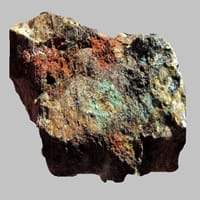Definition
Jasperoid is a rare, peculiar type of metasomatic alteration of rocks
Shale is a fine-grained sedimentary rock which is formed by the compaction of silt and clay-size mineral particles
Discoverer
Unknown
Unknown
Etymology
From silica, the main mineral content of Jasperoid
From German Schalstein laminated limestone, and Schalgebirge layer of stone in stratified rock. From Old English scealu in its base sense of- thing that divides or separate,
Class
Sedimentary Rocks
Sedimentary Rocks
Sub-Class
Durable Rock, Medium Hardness Rock
Durable Rock, Medium Hardness Rock
Group
Not Applicable
Not Applicable
Other Categories
Coarse Grained Rock, Fine Grained Rock, Medium Grained Rock, Opaque Rock
Fine Grained Rock, Opaque Rock
Texture
Earthy
Clastic, Splintery
Color
Black, Brown, Colourless, Green, Grey, Pink, White
Black, Brown, Buff, Green, Grey, Red, Yellow
Durability
Durable
Durable
Appearance
Glassy or Pearly
Muddy
Interior Uses
Decorative Aggregates, Floor Tiles, Homes, Interior Decoration
Decorative Aggregates, Homes, Interior Decoration
Exterior Uses
As Building Stone, Garden Decoration, Office Buildings, Paving Stone
As Building Stone, As Facing Stone, Office Buildings
Other Architectural Uses
Curbing
Curbing
Construction Industry
As a Flux in the Production of Steel and Pig Iron, As a Sintering Agent in Steel Industry to process Iron Ore, As Dimension Stone, Cement Manufacture, for Road Aggregate, Making natural cement, Manufacture of Magnesium and Dolomite Refractories, Production of Glass and Ceramics, Serves as an Oil and Gas Reservoir rock
Cement Manufacture, Construction Aggregate, for Road Aggregate, Making natural cement, Raw material for the manufacture of mortar
Medical Industry
Taken as a Supplement for Calcium or Magnesium
Not Yet Used
Antiquity Uses
Artifacts, Jewellery, Monuments, Sculpture
Artifacts, Sculpture
Commercial Uses
An Oil and Gas Reservoir, As a Feed Additive for Livestock, Gemstone, Metallurgical Flux, Production of Lime, Soil Conditioner, Source of Magnesia (MgO)
Creating Artwork, Pottery
Types
Not Available
Red Shale, Black Shale, Green Shale, Grey Shale and Yellow Shale
Features
Host Rock for Lead, Traps for subsurface fluids like Oil and Natural Gas., Zinc and Copper Deposits
Easily splits into thin plates, Generally rough to touch, Very fine grained rock
Archaeological Significance
Famous Monuments
Data Not Available
Jantar Mantar in India
Famous Sculptures
Data Not Available
Data Not Available
Formation
Jasperoid is a rare and peculiar type of metasomatic alteration of rocks. It is formed by extreme alteration of wall rocks within a shear zone which may occur in sediments, andesites, trachytes and basalts.
Shale forms when very fine-grained clay particles are deposited in water which settle at the bottom of water bodies. They are later compacted hence forming shale.
Mineral Content
Clay Minerals, Pyrite, Quartz, Sulfides
Albite, Biotite, Calcite, Chert, Chlorite, Dolomite, Hematite, Micas, Muscovite or Illite, Pyrite, Quartz, Silica, Sulfides
Compound Content
NaCl, CaO, Carbon Dioxide, Magnesium Carbonate, MgO
Ca, Fe, Mg, Silicon Dioxide, Sodium
Types of Metamorphism
Burial Metamorphism, Cataclastic Metamorphism, Regional Metamorphism
Not Applicable
Types of Weathering
Not Applicable
Biological Weathering, Chemical Weathering, Mechanical Weathering
Types of Erosion
Not Applicable
Chemical Erosion, Coastal Erosion, Glacier Erosion
Grain Size
Medium to Fine Coarse Grained
Very fine-grained
Fracture
Conchoidal
Not Available
Porosity
Less Porous
Highly Porous
Luster
Vitreous and Pearly
Dull
Specific Gravity
2.8-3
2.2-2.8
Transparency
Transparent to Translucent
Opaque
Density
2.8-2.9 g/cm3
2.4-2.8 g/cm3
Resistance
Heat Resistant, Pressure Resistant, Wear Resistant
Heat Resistant, Impact Resistant
Deposits in Eastern Continents
Asia
China, India
Bangladesh, China, India, Russia
Africa
Morocco, Namibia
Ethiopia, Kenya, Morocco, South Africa, Tanzania
Europe
Austria, Italy, Romania, Spain, Switzerland
Austria, France, Germany, Greece, Italy, Romania, Scotland, Spain, Switzerland
Others
Not Yet Found
Not Yet Found
Deposits in Western Continents
North America
Mexico, USA
USA
South America
Brazil, Colombia
Bolivia, Chile, Colombia, Ecuador, Peru, Venezuela
Deposits in Oceania Continent
Australia
New South Wales, Queensland, Yorke Peninsula
New South Wales, New Zealand, Queensland, Victoria, Western Australia
All about Jasperoid and Shale Properties
Know all about Jasperoid and Shale properties here. All properties of rocks are important as they define the type of rock and its application. Jasperoid and Shale belong to Sedimentary Rocks.Texture of Jasperoid is Earthy whereas that of Shale is Clastic, Splintery. Jasperoid appears Glassy or Pearly and Shale appears Muddy. The luster of Jasperoid is vitreous and pearly while that of Shale is dull. Jasperoid is available in black, brown, colourless, green, grey, pink, white colors whereas Shale is available in black, brown, buff, green, grey, red, yellow colors. The commercial uses of Jasperoid are an oil and gas reservoir, as a feed additive for livestock, gemstone, metallurgical flux, production of lime, soil conditioner, source of magnesia (mgo) and that of Shale are creating artwork, pottery.










